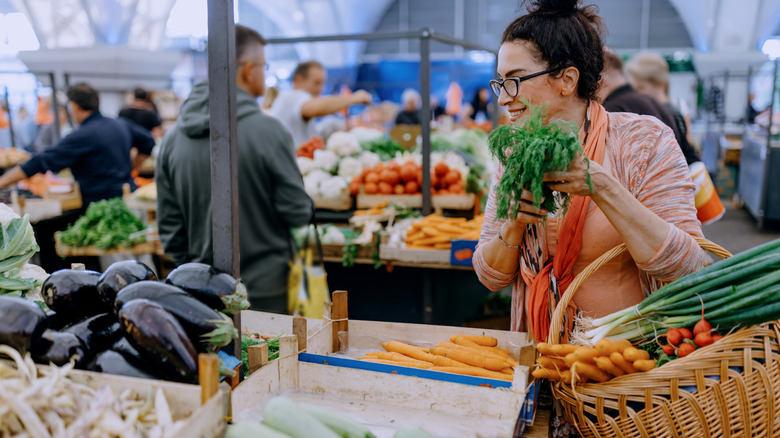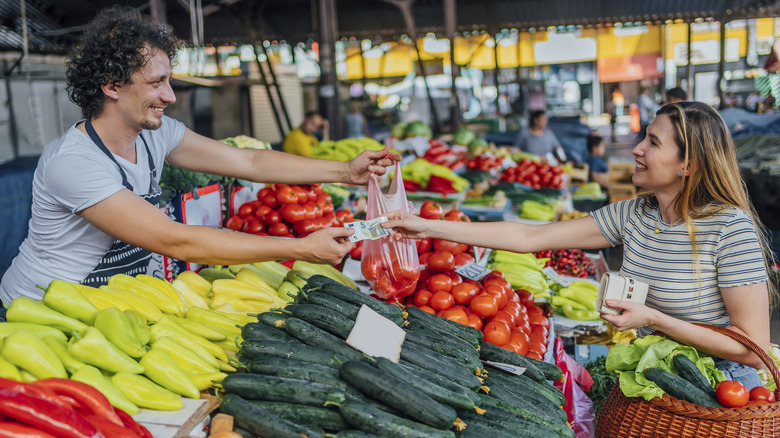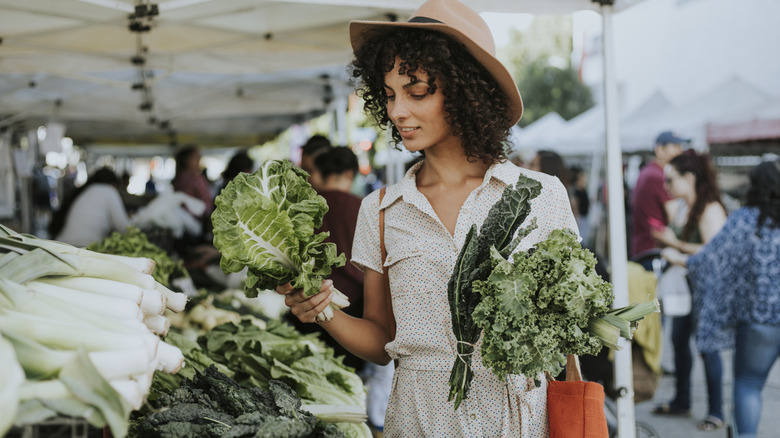The First Rule Of Good Farmers Market Etiquette
For those of us that love to cook (and eat), one of the most anticipated aspects of summer is the arrival of local farmers' markets. Depending on your community, once a week, ranchers, artisans, bakers, and farmers gather to offer their goods made and grown locally, sometimes harvested that morning at the peak of freshness.
Supporting direct-to-consumer producers gives us an opportunity to meet and learn from the people growing our food. Still, unlike shopping at a big supermarket, there are unspoken rules and etiquette for navigating everything from small roadside stands to sprawling farmers' markets.
In planning a trip to the farmers' market, the first rule is to bring cash in small bills — the paper stuff we rarely use anymore. Not all vendors will be able to make change for $100, and some farm stands work on an honor system, so unless you are willing to spend that much on ingredients for a salad, it's best to stop at an ATM first.
Avoid using credit cards if you can
While some vendors take credit cards, they will all appreciate cash and sometimes offer a lower price for paying that way. Paying with cash eliminates the fees credit card processing companies charge vendors for using the service. Although it's nice to rack up points and miles on your credit cards, purchases made with American Express, Discover, and rewards cards charge the vendor higher interest rates than non-reward Visa and Mastercard versions, meaning the seller gets less of the sale. If you really must use one, use your debit card. It sets the lowest fees for the seller since it's low risk for the banks.
Vendors are more likely to negotiate the price of an heirloom tomato when you only have five dollars, but flashing a credit card eliminates your bargaining power. Still, before you haggle over a pint of berries for sport, consider the expenses and labor involved in growing food, especially with the impact of global warming and increasing droughts.
According to the United States Department of Agriculture, there has been a sharp decline in the number of U.S. farms and total acres dedicated to growing our food over the past century, with the country losing almost five million farms since 1935. Nearly 89% of U.S. farms today are small family-run operations. Unfortunately, due to many factors, farm production expenses are forecasted to increase in 2023, while net farm income will decrease by 18.2% compared to 2022.
The benefits of shopping local
Shopping locally benefits everyone, including the environment, but perhaps the consumer the most. Food grown locally is fresher than produce shipped across the country, which is days old when it reaches the supermarket. Seasonal fresh fruit and vegetables taste better, have more nutrients, and have a lower carbon footprint than out-of-season ingredients that were flown in.
Unlike a typical supermarket that only stocks cantaloupe and honeydew, farmers' markets can offer a wider selection, selling six types of melons you've never heard of. If you are unfamiliar with an item, kindly ask for a sample. Farmers are more than willing to educate consumers on what they've grown and are proud to share it.
Remember to bring your bags when heading to a farmers' market. Most vendors aren't equipped to provide one, and it's greener anyway. Locally grown can last longer than supermarket food if stored properly, so don't be afraid to buy enough fruit and vegetables to hold you over until next week. Each week the market will transform, offering new crops, so it's a good idea to carve out some time to wander, get inspired, and be thankful your community has access to it.



